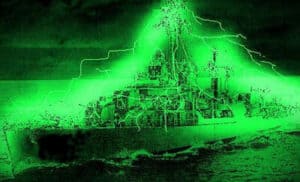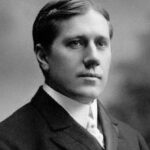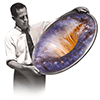…or as it’s known here in the Parallel Universe, simply ‘TPX.’
So what’s all this about ‘The Philadelphia Experiment’ and what’s that go to do with Townsend Brown??
Over the next few days or weeks I’m going to pull the scales off this topic. I am motivated in part by a comment / review that was post on Amazon.com by one of the readers of the unfinished 2009 manuscript edition of what is now The Man Who Mastered Gravity:
Indeed. So let us commence to dwelling.
I stand by my assertion that TPX is a myth, and that there is nothing beyond blind speculation that Townsend Brown had anything to with… well… anything.
There is however an inference in my book that Brown was involved in something in Philadelphia in the mid-1960s with a submarine called The Cutlass. That same vessel experienced a ‘ball lightning’ event twenty years earlier.
In one of his first messages to me in 2004, ‘Morgan’ implored me to ‘stick with ball lighting like spit on chewing gum… I will get to all that in a subsequent post. But let us begin with this AI generated answer to the question posed in the title of this post:
Was Townsend Brown Involved in Project Rainbow?
Thomas Townsend Brown’s work on anti-gravity and propulsion systems has led to speculation that he was involved in Project Rainbow, a highly classified government project that allegedly focused on experiments with invisibility and time travel. The extent of Brown’s involvement in Project Rainbow remains a topic of debate among researchers and conspiracy theorists.
Some claim that Brown was a key member of the Project Rainbow team, and that his experiments with electrogravitics were integral to the project. Others argue that there is no concrete evidence linking Brown to Project Rainbow, and that the project itself may never have existed.
T. Townsend Brown’s Involvement in Project Rainbow
Project Rainbow, also known as the Philadelphia Experiment, is/was an alleged experiment conducted by the US Navy during World War II to make a ship invisible to both radar and the naked eye. Over several decades, T. Townsend Brown has been linked to this project.

Some sources claim that Brown was a key figure in Project Rainbow and that he developed the technology that made the USS Eldridge invisible. However, there is no concrete evidence to support these claims, and some researchers have dismissed them as conspiracy theories.
What is known is that Brown had a strong interest in electromagnetism and gravity, and he conducted experiments in these fields throughout his career. He is also credited with developing the Biefeld-Brown effect, which is the phenomenon of a capacitor generating a net force when charged with high voltage.
There are reports that Brown worked with the Navy during World War II, but it is not clear what his role was or if it had anything to do with Project Rainbow. Some sources suggest that he may have been involved in the development of radar and other military technologies.
The Philadelphia Experiment
The Philadelphia Experiment is a naval military experiment that allegedly took place in the Philadelphia Naval Shipyard in 1943. The experiment was said engage Einstein’s unified field theory to make the USS Eldridge, a destroyer escort class ship, invisible by generating an electromagnetic field around the ship.
According to some accounts, the experiment was a success, and the ship disappeared from view – only to reappear moments later in a different location. Other accounts suggest that the experiment was a failure, causing the ship to become engulfed in a green fog and leading to the crew members suffering from various health problems, including nausea, disorientation, and even insanity.
Despite the many claims and conspiracy theories surrounding the Philadelphia Experiment, no concrete evidence has ever been found to prove that it actually took place. The US Navy has officially identified the experiment as mythical, having its genesis in a 1955 book on UFOs, not Naval research.
Controversies Surrounding Brown’s Involvement
Some researchers claim that Townsend Brown helped develop the technology used in the experiment. They argue that Brown was part of a secret government program that aimed to create a device that could make a ship invisible to radar.
However, there is little evidence to support these claims. Brown himself denied any involvement with the project, and there are no official records that suggest otherwise. Some researchers argue that the lack of evidence is due to the secrecy surrounding the project, but this is purely speculative.
Another controversy surrounding Brown’s involvement with the project is related to his expulsion from the National Investigations Committee on Aerial Phenomena (NICAP). Some researchers claim that Brown was forced out of the organization because he was using funds to further his own anti-gravity research, which was unrelated to the investigation of UFOs. Again, there is little evidence to support these claims.
Conclusion
After researching the available information about T. Townsend Brown and Project Rainbow, it is difficult to come to a definitive conclusion.
It is clear that Brown was a brilliant and innovative scientist who made significant contributions to the field of electrogravitics. His work with the Biefeld-Brown effect and his development of hovering platforms demonstrated his ability to think outside of the box of what was considered possible.
Brown’s involvement in Project Rainbow remains a mystery. While some authors, such as William L. Moore and Charles Berlitz, claim that Brown was an integral part of the project, others, such as Jacques Vallee, dispute its existence altogether.
It is possible that the truth lies somewhere in between. Brown’s work with electrogravitics and anti-gravity research may have overlapped with the goals of Project Rainbow, but it is unclear whether he was directly involved in the project itself.

OK, that’s enough of that. It’s going to take more than a strip of digital duct-tape to adhere Townsend Brown to a ship supposedly disappearing in 1943.
But my correspondence with Morgan and O’Riley suggests that there is something to investigate there. As O’Riley said,
The name the Eldridge was a nod to a prominent ‘Caroline Group member – Eldridge Johnson. It had nothing at all to do with the experiment that was going to eventually mean so much to so many. It was the good old Cutlass.
I’ll get into that in the next post.
Stay tuned!

